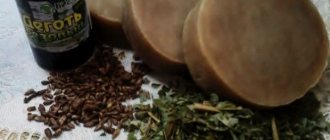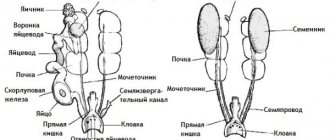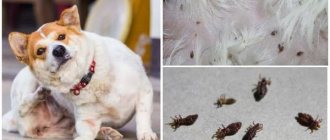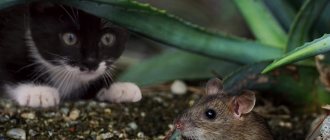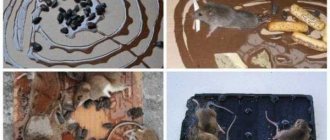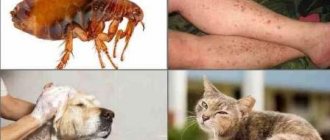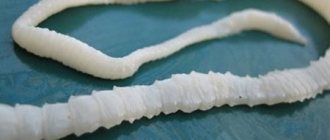The house mouse and gray rat have been “accompanying” humans since time immemorial - it is thanks to their ability to coexist with bipeds that these rodents have spread throughout the world and today are one of the most numerous species of mammals.
Alas, this neighborhood is not always favorable for humans. Mice and rats cause damage to crops, and cause the main damage by eating and contaminating food and animal feed with their excrement, as well as damaging furniture, electrical wiring, clothing, books and other items that they sharpen their teeth on.
But that's not all. Gray rodents are carriers of many infections that are dangerous and even in some cases fatal to humans. A number of such infections are transmitted through their urine and feces, others through blood-sucking arthropods that easily pass from mice to humans.
Let's talk in more detail about possible diseases transmitted by mice and rats to humans.
Plague
People who are more or less familiar with world history have, of course, heard about the largest plague epidemics in the Middle Ages, when the mortality rate in infected settlements exceeded 95%. The famous plague epidemics, which claimed millions of lives and devastated vast territories, left a deep mark on the history of all mankind. And the last pandemic was not as long ago as it seems - only in the middle of the 19th century in China! Moreover, large outbreaks of the disease were recorded in India in the 20th century, and in a number of countries (especially Africa and Asia, although there are natural outbreaks even in Russia) they still occur to this day.
We, of course, are not Africa, and with the development of medicine, the mortality rate of the disease has now been reduced to approximately 5-10%, but it would not hurt to know about the possible danger.
The causative agent of plague is the bacterium plague bacillus, and its sources and carriers are all kinds of rodents, both wild and synanthropic (accompanying humans), as well as rat fleas. The “gate” of infection is skin or mucous membranes damaged by a bite. An infected person, in turn, becomes a potential source of a disease in which transmission of the pathogen to another person or animal, depending on the form of the disease (and there are several of them), can be carried out by airborne droplets or contact.
The clinical picture of plague varies, but in any case it is an acute infectious disease that occurs with an extremely severe general condition, fever, damage to the lymph nodes, lungs and other internal organs, often with the development of sepsis.
Tests and diagnostics
The disease is difficult to recognize in the first days. In addition, its symptoms can be confused with the symptoms of other diseases. However, the clinical picture of mouse fever differs from ARVI in the absence of a runny nose and symptoms of respiratory tract damage, and from an intestinal infection - by the later development of symptoms of gastrointestinal damage.
The main diagnostic signs are a sharp decrease in the amount of urine, as well as a deterioration in the person’s general condition after the temperature normalizes. The doctor makes a diagnosis based on the clinical picture, epidemiological history, as well as changes in kidney function characteristic of murine fever.
Laboratory data are taken into account. The following analyzes are carried out:
- general blood test with examination of the leukocyte formula;
- biochemical blood test - determination of creatinine , urea , alanine aminotransferase , aspartate aminotransferase , study of blood electrolytes;
- general urine analysis;
- A coagulation test is performed to assess the severity of the disease.
Instrumental research methods are also practiced:
- Ultrasound of the kidneys;
- X-ray of the lungs;
- fibrogastroduodenoscopy;
- ECG, etc.
Hemorrhagic fever
Mouse fever is the popular name for this serious disease, which is officially called “hemorrhagic fever with renal syndrome (HFRS)” due to the main carrier of the causative virus.
As you already understood, the disease is transmitted by mouse-like rodents (mainly forest and field), or rather, the disease is transmitted through airborne dust or with dirty hands while eating in places where there is a lot of excrement of infected mice or rats on the surface (“in nature”, in rarely visited summer cottages, etc.).
Most often, tourists and rural residents are susceptible to HFRS in the summer. It has also been established that men suffer from the disease more severely than women, and people with reduced immunity are also at risk.
The disease is dangerous because the first signs resemble an acute acute respiratory infection, so many people let the course of HFRS take its course. It begins suddenly - the temperature rises sharply to 38-40 degrees, a severe headache, and chills appear. On the 3-4th day, a skin rash in the form of small hemorrhages may appear. Bleeding from the gums and nose occurs. Due to kidney damage, pain appears in the lower back and abdomen, and vomiting is not associated with food intake. If treatment is not started in time, the disease will hit the kidneys so hard that it can even lead to death. The mortality rate when infected with a more dangerous form of the virus and untreated can reach 20%.
Treatment with folk remedies
The use of folk remedies for this disease can be an effective auxiliary method. But only if they are pre-approved by a doctor. In addition, one or another method should be used precisely during a certain period of illness, which should also be consulted with a specialist.
- Flax seeds . The decoction is useful for strengthening the kidneys and restoring their function. Prepare a decoction by pouring 1 tsp. seeds with a glass of water. The product must be boiled for 5 minutes. Use half a glass every 2-3 hours for 2 days.
- Birch leaves . To prepare the infusion, pour 100 g of young leaves into 2 tbsp. hot water. After 6 hours, the product should be filtered and drunk 3 times a day, 100 ml.
- Horsetail . 2 tsp. dry raw materials need to be filled with 1 tbsp. boiling water After an hour, strain and drink throughout the day.
- Lingonberry leaves . 2 tbsp. l. raw materials pour 1 tbsp. water and keep in a water bath for half an hour. Drink half a glass 2-3 times a day. You can also prepare an infusion of strawberry leaves, which have a diuretic effect and are a source of vitamin C.
- Dill seeds . Diuretic. 1 tsp. dill should be poured 1 tbsp. water and cook for 5 minutes. Drink 50 ml three times a day.
- Series . Also has a diuretic effect. To prepare the infusion 4 tbsp. l. sequence you need to pour 1 liter of boiling water. After infusing overnight, take 100 ml three times a day.
It is also recommended to prepare decoctions and infusions from herbal collections. To prepare the decoction, 1 tbsp. l. The product needs to be poured into 1 glass of water and boiled for several minutes. Drink half a glass three times a day. Under this scheme, the following fees can be applied:
- 2 parts bearberry and juniper fruit, 1 part licorice root.
- 2 parts each of birch leaves and licorice root, 1 part bearberry.
- 4 parts juniper fruit, 3 parts each angelica root and blue cornflower.
- 5 parts each of knotweed and corn stigmas, 3 parts of hawthorn fruits, 2 parts each of poplar buds, pine and rowan fruits. This remedy should be boiled for 15 minutes, drink three-quarters of a glass an hour before meals, twice a day.
It is also recommended to introduce into the diet some foods that help improve the condition. It is useful to consume pumpkin seeds, berries and currant juice, strawberries, raspberries, blackberries, pumpkin, and figs. Watermelon has a diuretic effect.
During the recovery period, it is recommended to drink vitamin teas. They can be prepared from rose hips, hawthorn, raspberry leaves, strawberries, lingonberries, etc.
It is also recommended to use baths during recovery from illness:
- From horsetail . Add a decoction of 700 g of dry horsetail herb to the bath (boil for 30 minutes before).
- From pine . Boil cones and needles (1-1.5 kg) for half an hour and leave for 12 hours.
Rat (endemic) typhus
Unlike epidemic typhus, the picture of which is usually presented when this disease is mentioned, the main carrier of this type of disease is not lice, but the same rat fleas that live on intermediate hosts - mice and rats.
The causative agent of typhus is intracellular parasites, special bacteria of the genus Rickettsia. Once in the human body after the bite of a flea carrier, the bacteria multiply in the lymph nodes, and then are released into the bloodstream and spread throughout the body. First of all, they damage the inner surface of blood vessels, which leads to clinical changes in many systems - from the nervous to the circulatory. The course of the disease is characterized by skin rashes, a sharp increase in temperature, fever, headaches and back pain, retardation of consciousness, as well as associated complications.
In general, rat typhus is milder than its epidemic variety and in our time is no longer fatal. It is found in both hemispheres, in regions with a fairly mild climate. However, today, for example, in the United States, about 40 cases of this disease are registered annually - mainly in the summer and mainly among rural residents.
For the prevention of rat typhus, control of rodent carriers is extremely important.
- 10 ideas on how to get rid of mice in a country house (only proven means!)
Rodent control methods that will make them capitulate.
Methods of transmission of diseases from mice
There are several possible ways of contracting infectious diseases from rodents. The vast majority of them occur after contact with the mouse itself or the results of its vital activity.
Access to food
Transfer methods:
- bites and scratches received from rodents;
- insect bites that parasitize mice;
- eating foods chewed by mice or contaminated with their excrement;
- contact of mouse feces on mucous membranes or open wounds;
- direct contact with the corpse of a rodent;
- by inhaling dust containing mouse hair and droppings.
Pet owners who actively hunt rodents who are wondering whether it is possible to catch mouse fever or another disease from a cat can be reassured that fever cannot be passed on to humans from a pet. But diseases transmitted, for example, by a flea bite, can pass to a cat, and from it to a person (and often with the insect itself).
Leptospirosis
This series of infectious diseases has also been registered on all continents, and the mortality rate in case of severe infection can exceed 20% even in developed countries (for example, deaths were registered in 2022 in Ukraine).
The causative agents - leptospira bacteria - live in the body of animals that are intermediate hosts, including mice and rats. The bacterium is excreted from sick animals in the urine and can live for weeks or months in contaminated water, grass and soil. People can become infected by drinking raw water from natural sources or while fishing or swimming in bodies of water, through wounds or mucous membranes when in contact with sick animals. The likelihood of such infection increases in stagnant or low-flow water, in contaminated premises, and in livestock-raising regions with an abundance of livestock.
Leptospirosis is characterized by a pronounced seasonality with a maximum incidence in August.
More than half of the cases of leptospirosis are severe and require resuscitation measures, although asymptomatic variations of the disease also occur. In acute patients, the functioning of the gastrointestinal tract is disrupted, muscle pain (especially in the legs and lumbar) and severe headaches, fever, jaundice, and vomiting appear. If you do not see a doctor in time, even death is possible.
To prevent infection, personal hygiene rules and strict rodent control in areas must be followed. Vaccination against leptospirosis is also provided for unfavorable agricultural areas.
Prevention of infection
You can become infected with an infectious disease from mice living in your home without even meeting them. Therefore, the most effective way to avoid infection is to kill rodents. In addition, the following recommendations will help to significantly reduce the risk of contracting an infection:
- it is necessary to properly store food and water so that rodents cannot get to them;
- vegetables and fruits brought from the basement must be thoroughly washed, peeled and it is better not to eat them raw;
- it is necessary to periodically inspect food supplies and throw away all products damaged by mice;
- You cannot catch live rodents or touch dead ones with your bare hands;
- You should not take wild rodents into your home in the hope of taming them;
- You should regularly clean the house (spring cleaning is especially important if the house has been closed for the winter);
- It is better to work in the area with gloves, and wash your hands thoroughly afterwards;
- when swimming in open waters, you should not take water into your mouth, much less swallow it;
- The garden plot must be kept clean and construction and plant debris must be removed in a timely manner.
Vegetables, berries, and herbs collected from the site must be thoroughly washed before use.
Speckled skin
Microsporia or ringworm is one of the most common skin diseases of animals. When people become infected from them, people also get sick: small spots appear on the skin, covered with gray scales; there can be from two to a hundred of them on the human body. The causative agent of microsporia also affects the hair, so sometimes during treatment the head has to be shaved, which is very unpleasant for the patient. If you notice even a slight redness in the shape of a circle or ring, do not be lazy - go to a dermatologist. If time is lost, curing the disease will be much more difficult.
What does a sick rodent look like?
A breeder of rats and mice should be aware of a number of signs that may indicate ill health in a pet.
Suspicious symptoms:
- change in behavior (apathy, aggression);
- discharge from the eyes, cloudy cornea, sticky eyelids;
- dull and unkempt fur;
- nasal discharge, mucus, crusts;
- unusual posture, tension.
Diseases of the cardiovascular system are characterized by a lack of air, the rodent falls on its side. Urine will “tell” about kidney diseases; it is cloudy, with impurities, a pungent odor, and discolored. Constant itching, bald spots, and hair loss indicate skin parasites.
All decorative rodents have problems with teeth. In nature, they constantly chew on objects, grinding down their teeth. Pets at home do not have the opportunity to move freely and choose. If the owner does not take care, there is a risk of excessive growth of the incisors, damage to the soft tissues of the skull and bones.

